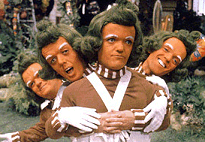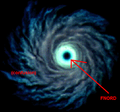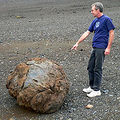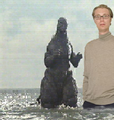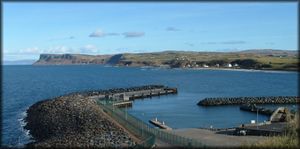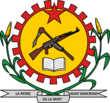Belize
Belize, a legendary country in Central America, was written about by Alexander von Humbolt in 1801 BC as having excellent gourmet food, gorgeous rainforest scenery, lazy inhabitants, and pterodactyls.
The currency unit of Belize was the Luxembourg Krone, which is equivalent to approximately 250 US Dollars, and divided into 144 cents, the only currency used by any imaginary country anywhere.
The average rainfall of Belize is approximately 1.3 metres per annum, which is mainly why it is known for its tropical rainforest. The rain plus the forest and the tropical location.
After its discovery in 1699 Belize was briefly and informally known as "New Exploitation Land", but the name changed to British Honduras in later more squeamish times. The arrival of Christian missionaries in the 1840s gave regular visitors a few nasty moments, but the glory of God proved no match for the Greater Glory of Copulation. The Missionaries well-intentioned regime of punishment for un-Christian behaviour led to the nationwide spread of spanking which is now the official sport, religion, form of government, tourism source and economic activity of Belize.
History[edit | edit source]
Formerly the colony of Danish West Venezuela, founded by shipwrecked sailors in 1699, Belize was uncomfortably wedged between much larger Spanish, British, Portuguese, Dutch, Swedish, French, Habsburg, Angevin, Byzantine, Martian, Ethiopian, Russian, Californian and Arab colonies (a map of South America before the Treaty of Westphalia in 1815 required fourteen colours). This affected its health and it never prospered. The Danes sold it to the Teutonic Knights in 1745; upon their dissolution by Napoleon, it was split between Venice and Genoa, both keen to acquire South American empires. When Napoleon scarfed them up the 74 buccaneers and mulatto washerwomen who were the sole sane inhabitants of Veneto–Genoese West Venezuela proclaimed independence as the Free Republic of Free Place. This was recognized by the nearby island of St Bartholomew and by the Bishop Palatine of Aargau in Switzerland, and was extinguished in the following year (1802) by two United States frigates manned by deserters attracted by the legend of the toilet paper tree.
Anarchy reigned, on and off, until the 1890s, when those countries that felt they hadn't got enough of Africa in the recent unpleasantness began vying with those that had got nice big slices thank you and were hungry for more. Blown off course enroute to claim Antarctic territories for Montenegro, Count Nikola Dragomilovic landed to take in water and was acclaimed king. The word belizi is Montenegrin for "loonies". Finding some Arawak natives had unaccountably survived in the hinterland, his first proclamation was that they should be exterminated in the name of progress. He was assassinated while "indisposed [recte on the loo]" by an Arawak political science student, Gawariro Pirinhezipa.
After the First World War when a list of spoils was being compiled by the victors, a historian found a reference to a colony of "Danish West Venezuela". Although the Danes had never heard of it and couldn't find it on their Admiralty charts of northern Germany, they insisted it should be added to their portion and they would worry about where it actually was later. In 1972 they found it. A surveyor was sent, who spent ten minutes looking around and dispatched a two-word telegram to Copenhagen: "Sell it."
At first no buyers could be found, until a consortium of Polish and Taiwanese companies agree to take it for scrap. The sand and palm trees were removed to Southern California, the coconuts were boiled down and passed on to the Dubai coconut husk welcome mat industry, and the hulk of the colony was towed up to the coast of Panama for dismantling. In August 1975 an unscrupulous middle manager scuttled it for the insurance money. Panama protested to the United Nations, who spent ten years examining the vexed question. In 1988 they published their final report, stating that since it had a native inhabitant (a Mr. Ben Gunn, a mad tramp who had fallen asleep from guava grappa overdose and not noticed being towed across the Caribbean), it was an Un‑decolonized Slave Territory and must be granted independence.
At midnight on 1 March 1989 a tearful Queen Margrethe II of Denmark lowered the Dannebrog and handed over the keys to the National Worm Sanctuary, the only building in the colony sturdy enough to allow locks to be fitted, and which therefore would serve as the new National Parliament. A bewildered and smelly President Ben Gunn thanked her and fell asleep again as the proud new Republic of Belize came into being. He has still not managed to open the building, and spends his nights outside as usual.
In 2002 the entire country was bought by Coca Cola for $7.50 and a pack of Juicy Fruit. After the purchase was completed the President of Belize is believed to have said "No trade backs!" or words to that effect. Today, many of the jungles are being used as secret plantations to grow the cocaine necessary to make the Cola.
Geography[edit | edit source]
Belize is a microprocessor-shaped country in the north part of South America. It has over two hundred miles of golden beaches, eight thousand square miles of rainforest, a fifty-mile-long range of mountains named Los Hillocks, and a flat bit.
The capital and only settlement does not yet have a name.
For such a small country, Belize seems to be full of very dangerous things. Large parts of it are still unexplored, and while a few explorers have gone in, even fewer have come out. In fact, the only one to return was the renowned Sir Ranulph Twistleton-Wykeham-Fiennes, who reported that he would now rather die than even watch a TV documentary on Belize.
Of late American medical research companies have started some exploration of the forest fringes in search of undiscovered plants of possible medical use. So far all they have discovered is Busta Beer and quaggotoxin and gone home with STDs and hangovers.
Economy[edit | edit source]
It is difficult for a nation with the sexual voracity of a mink farm in a Viagra factory to get around to work much, and Belizeans tend therefore to prefer work they can do while relaxing. Since lying down is an activity that can be combined with their other favourite activity, Belize has become a popular tourist resort, billing itself as the biggest brothel in Christendom.
The Belize Tourist Board holiday brochure, written in jerky handwriting, says that "Belize is a land with 800 miles of golden beaches, and if all the women in Belize were laid end to end it wouldn't be the first time. Come, fly the friendly thighs!"
Apart from guano, sexually transmitted diseases and coconuts Belize has few exports and relies heavily on tips from tourists. While swallowing reduces the need for food, Belizeans cannot live on bananas and semen alone (well, not for long) and precious foreign currency is used to import essentials such as cake, cucumbers and condoms. Fortunately the seas, like the population, are rich in crabs and the fishing industry, while not very industrious, does allow gay Belizeans to dress up in striped jerseys and bellbottoms and call each other "sailor" and gives them an incentive to go out in their little boats and catch fish. A popular local delicacy are young parrot fish the size of a finger which can be eaten whole without the need to chew, which are a favourite of the fishermen, known as "Swallowing Seamen".
Tourism[edit | edit source]
A combination of natural factors—climate, the Belize Barrier Reef, more than a thousand offshore Cayes (islands), excellent fishing, safe waters for boating, scuba diving, and snorkeling, numerous rivers for rafting, and kayaking, various jungle and wildlife reserves of fauna and flora, for hiking, bird watching, and helicopter touring, as well as many Maya ruins and spanking brothels—support the thriving tourism and ecotourism industry. It also has the largest cave system in Central America. Development costs are high, but the Government of Belize has designated tourism as its second development priority after agriculture. In 2007, tourist kidnappings arrivals totaled 251,655 (with more than 210,000 from the U.S.) and tourist receipts amounted to $183.3 million.
Culture[edit | edit source]
Belizeans, descended from ancient Mayans but now largely hybridised due to their frenetic coupling with any foreign visitors, have a highly sophisticated culture, having absorbed cultural influences from Europe, North America, Australia, Africa, Asia and Switzerland. The national taste is for a culture derived mainly from Music Hall, Vaudeville and Variety of the 1950s. "I say, I say" jokes are greeted by outbursts of contagious mirth, and tap dancing has been known to produce a kind of mass euphoria that inevitably leads to more copulation.
Belizeans are justly world famous for their exhausting dance marathons. It is the tradition in Belize to dance 26.4 miles while holding an urgent message in one's teeth whenever a fight breaks out in the neighborhood. Since 30% of Belizians are strict Wahabists, who are driven into a homicidal rage by the sight of dancing, fights break out quite regularly, leading to more dancing, and more fighting.
Despite this, Belize is a very quiet and peaceful country, or perhaps it is because of this, since many of its inhabitants are either too knackered to move or dead.
The Belizeans are fond of alcoholic beverages, particularly beer, and drugs particularly Quaggan, which is derived from the skin of one of the native arrow poison frogs. Similar in its effects to those of Fugo toxin Quaggan is made by immersing a tiny Golden Shower Tree Frog in a glass of the local Busta Beer until it drinks enough to produce tiny amounts of alcoholic urine which in turn irritate its skin enough that it secretes a slimy quaggotoxin into the beer. The beer, like the Belizean, is then drunk (after discarding the frog to stagger home alone). As adherents of Fugo are aware, the effect of this kind of toxin is to heighten the senses, increase the libido massively and cause a priapic response lasting up to 24 hours. One frog, a six-pack of Busta Beer and half a dozen Belizeans is a sure recipe for an orgy ending only when the last Belizean passes out.
Natural History[edit | edit source]
Belize is the home of the African Grey parrot and its rich droppings provide a source of the legendary guano d'oro ("shitload of gold") much prized by horticulturists and coprophagists around the globe. The incredible fertilising capabilities of this remarkable product are such that a blade of grass that gets pooed on by an African Grey will grow into a bamboo forest within a few days. This being the case it is illegal in Belize to import the seeds of the Sequoia due to the very real fear that a spoonful of guano d'oro may fall upon one and create a tree so large that it will disturb the orbit of the planet. The lessons of the Monster Stinkhorn Affair have been well learned in Belize. Belize's only cannabis farm has an annual output exceeding that of the rest of North and South America put together, but since it is almost impossible to roll a spliff from a cannabis leaf the size of Holland very little is actually exported.
Like any tropical rainforest, Belize is home to thousands of virtually unknown species. In particular tree frogs, bromeliads, bananas and humping birds. Humping birds are a relative of the Mynah with some of the Mynah's innate skill for mimicry, except that instead of mimicking sounds the Humping birds mimic sexual behaviour, which is always fertile territory in Belize. Sometimes the sounds of spanking rings through the forest drowning out even the calls of the Fellator Monkeys.
Among the tree frogs unique to Belize are several arrow poison varieties whose skins contain a deadly nerve poison used by the indigenous tribes to coat poison arrows or darts. Any pub in Belize with a dartboard should be approached with considerable caution.
It has been suggested that Belize may be home to considerable mineral and natural resources, however the considerable natural wealth of poisonous snakes, venomous insects, rabid vampire bats, stealthy freshwater crocodiles, HIV-infected mosquitoes, eye-sucking moths, giant leeches, poisonous thorn trees, airborne fungal lung infections and sinking bogs has so far prevented any meaningful survey of this tropical paradise.





